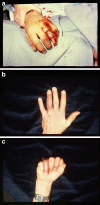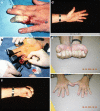Ring injuries of the finger: long-term follow-up
- PMID: 25191156
- PMCID: PMC4152427
- DOI: 10.1007/s11552-014-9651-9
Ring injuries of the finger: long-term follow-up
Abstract
Purpose: The purpose of this study was to report on the injury patterns and outcomes of a series of patients treated at our institution between the years 1983 and 2010 who were injured by rings worn on their finger. The series included typical ring avulsion injuries as well as all other injuries caused by rings.
Methods: Retrospective chart review was conducted on 33 patients with ring injuries treated by the senior author and colleagues. Eight cases were classified as Urbaniak class I, 13 class II, and 12 class III.
Results: Satisfactory finger motion occurred with salvage of fingers in which no damage occurred to the proximal phalanx or flexor digitorum sublimus or profundus tendons. All patients with flexor tendon injury or proximal phalangeal fracture or both had loss of PIPJ motion and total active motion as compared to class II injuries without tendon and bone involvement. Four class III injuries were treated with replantation. One failed requiring revision amputation at the metacarpalphalangeal joint level due to ischemia. The remaining eight were treated by primary amputation.
Conclusions: As a guideline to digit salvage with ring injuries, the authors propose accurately documenting and basing treatment on all injured structures. Particular attention should be given to fractures of the proximal phalanx and laceration of the flexor digitorum sublimus and profundus tendons, as injury to these structures led to significant loss in mobility of the finger in this series. While some current guidelines advise revascularization of class II ring avulsion injuries, our series suggests caution in anticipating good results with sublimus or profundus tendon laceration and proximal phalanx fracture. If the profundus tendon only is lacerated, particularly in zone I injuries, results of finger salvage may still be acceptable, but associated (distal interphalangeal joint) DIPJ injury may require K-wire stabilization and later fusion. Replantation in class III injuries, while possible, is warranted only in select situations (patient-specific and cultural factors).
Keywords: Avulsion; Reconstruction; Ring.
Figures





References
Publication types
LinkOut - more resources
Full Text Sources
Other Literature Sources
Research Materials

